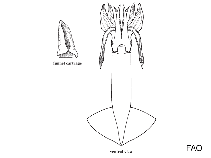Ornithoteuthis antillarum Adam, 1957
Bird squid| Native range | All suitable habitat | Point map | Year 2050 |

|
| This map was computer-generated and has not yet been reviewed. |
| Ornithoteuthis antillarum AquaMaps Data sources: GBIF OBIS |
Загрузить свой Фото
Изображение на Google | No image available for this species;
drawing shows typical species in Ommastrephidae.
Изображение на Google | No image available for this species;
drawing shows typical species in Ommastrephidae.
Классификация / Names народные названия | синонимы | CoL | ITIS | WoRMS
Cephalopoda | Oegopsida | Ommastrephidae | Ommastrephinae
Environment: milieu / climate zone / пределы глубины / distribution range экология
донно-пелагический; пределы глубины 0 - 1200 m (ссылка 417). Tropical; 41°N - 9°S, 95°W - 11°E (ссылка 275)
Distribution страны | регионы FAO | Ecosystems | места находок | интродукции
Atlantic Ocean: from Straits of Gibraltar to western Africa and the Caribbean. Circumtropical.
Length at first maturity / Size / Weight / Возраст
половая зрелость: Lm ? range ? - ? cm Max length : 30.0 cm ML самец/пол неопределен; (ссылка 104052)
Caught by squid jigs, dipnets, bottom trawls and midwater trawls. Maximum depth from Ref. 83938. Neritic, oceanic (Ref. 91956). Exhibits diel vertical movements (Ref. 275).
Life cycle and mating behavior половая зрелость | размножение | нерест | Eggs | Fecundity | Larvae
Members of the class Cephalopoda are gonochoric. Male and female adults usually die shortly after spawning and brooding, respectively. Mating behavior: Males perform various displays to attract potential females for copulation. During copulation, male grasp the female and inserts the hectocotylus into the female's mantle cavity where fertilization usually occurs. Life cycle: Embryos hatch into planktonic stage and live for some time before they grow larger and take up a benthic existence as adults.
Основная ссылка
ссылки | координатор | соавторы
Schneider, W. 1990. (ссылка 417)
Статус Красного Списка МСОП
(ссылка 130435: Version 2024-2)
Не вызывающий беспокойства (LC) ; Date assessed: 10 May 2010
Статус СИТЕС (ссылка 108899)
Not Evaluated
CMS (ссылка 116361)
Not Evaluated
Угроза для людей
Использование человеком
рыболовство: интереса не представляет
| FishSource |
инструменты
дополнительная информация
Trophic Ecology
экология
Population dynamics
рост
Max. ages / sizes
Length-weight rel.
Length-length rel.
Размерный состав
Mass conversion
пополнение
численность
Max. ages / sizes
Length-weight rel.
Length-length rel.
Размерный состав
Mass conversion
пополнение
численность
Life cycle
Distribution
Human Related
Aquaculture profiles
Stamps, coins, misc.
Stamps, coins, misc.
Outreach
Taxonomy
ссылки
ресурсы в Интернет
BHL | BOLD Systems | CISTI | DiscoverLife | FAO(Publication : search) | Fishipedia | GenBank (Геном, Нуклеотид) | GloBI | Gomexsi | Google Books | Google Scholar | Google | PubMed | Tree of Life | Wikipedia (Вперёд, поиск) | Zoological Record
Estimates based on models
Preferred temperature
(Ref. 115969): 8.6 - 20.5, mean 13.5 (based on 243 cells).



